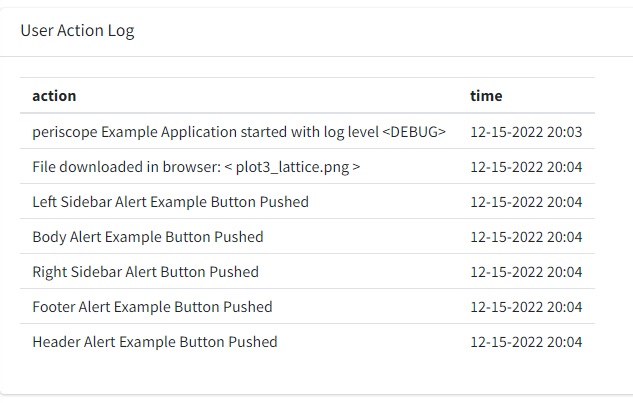Using the logViewer Shiny Module
Mohammed Ali
2025-09-02
Source:vignettes/logViewer-module.Rmd
logViewer-module.RmdOverview
Features
- Table contains two columns:
- action: describe the recorded action
- time: display action time
- The log files are kept in the /log directory and named ‘actions.log’. ONE old copy of the log is kept as ’actions.log.last
- Many actions are automatically logged by the framework and it is easy for developers to add additional items as they see fit.
- Filtering logs by setting log_level argument as desired in
set_app_parameters
- “DEBUG” will log logdebug, loginfo, logwarn, and logerror messages
- “INFO” will log loginfo, logwarn, and logerror messages
- “WARNING” will log logwarn and logerror messages
- “ERROR” will log logerror messages
- It is important to note that the log rolls over for each session and is reset if using the appReset module.

Usage
Shiny Module Overview
Shiny modules consist of a pair of functions that modularize, or package, a small piece of reusable functionality. The UI function is called directly by the user to place the UI in the correct location (as with other shiny UI objects). The module server function that is called only once to set it up using the module name as a function inside the server function (i.e. user-local session scope. The first function argument is a string that represents the module id (the same id used in module UI function). Additional arguments can be supplied by the user based on the specific shiny module that is called. There can be additional helper functions that are a part of a shiny module.
The logViewer Shiny Module is a part of the periscope2 package and consists of the following functions:
- logViewerOutput - the UI function to place the button in the
logViewerOutput
The logViewerOutput function is called from the ui_body.R (or equivalent) file in the location where any other UI element (box) can be placed.
# Inside ui_body.R
logViewerOutput("logViewerId")Sample Application
For a complete running shiny example application using the logViewer module you can create and run a periscope2 sample application using:
library(periscope2)
app_dir = tempdir()
create_application(name = 'mysampleapp', location = app_dir, sample_app = TRUE)
runApp(paste(app_dir, 'mysampleapp', sep = .Platform$file.sep))